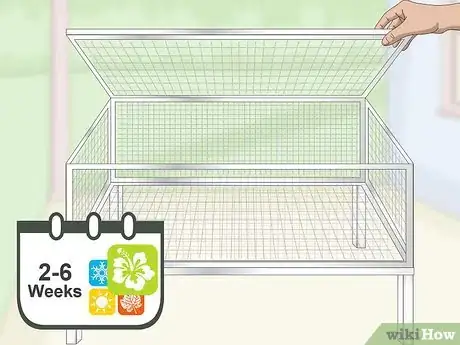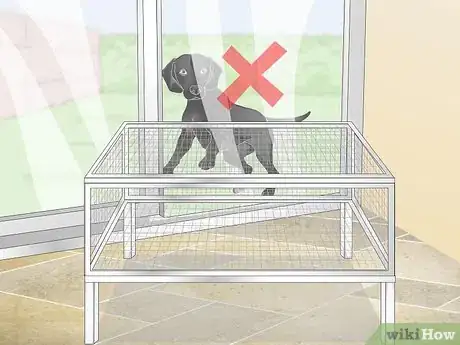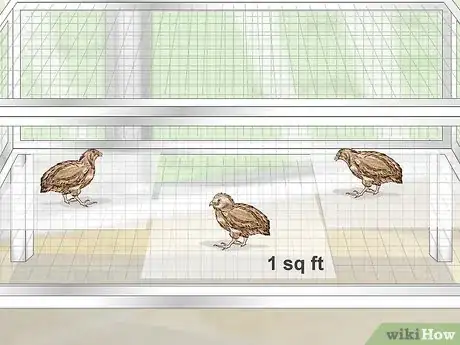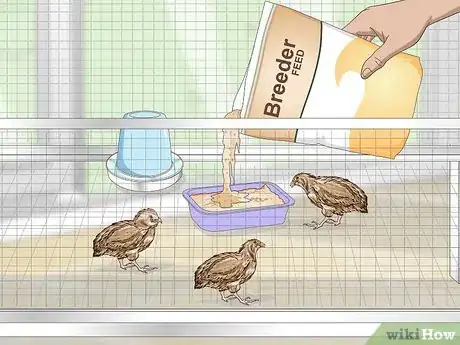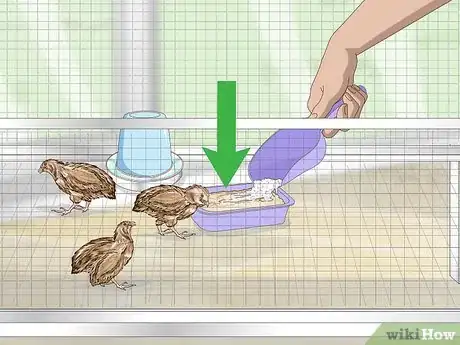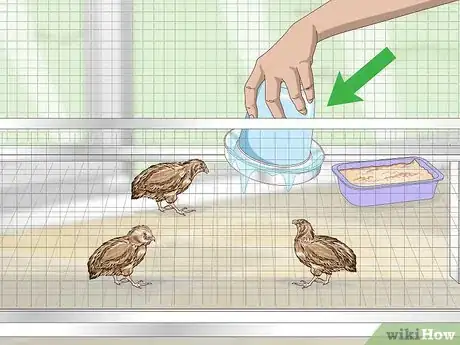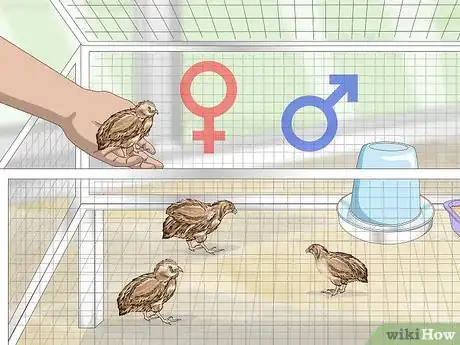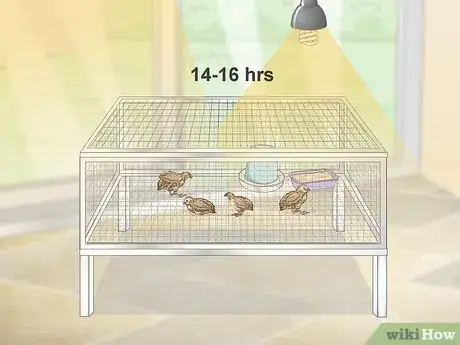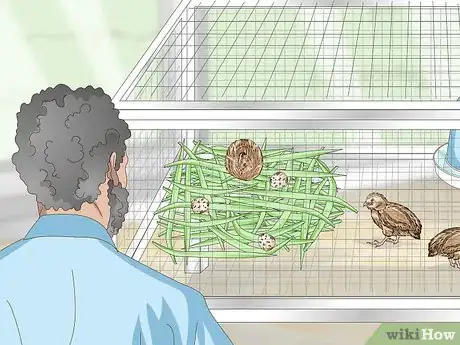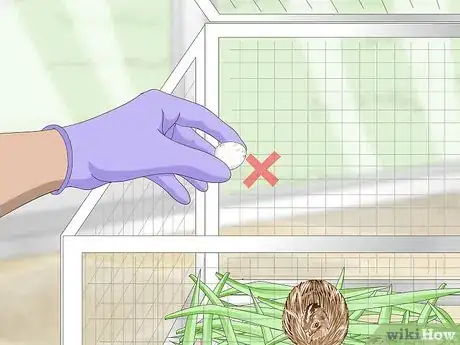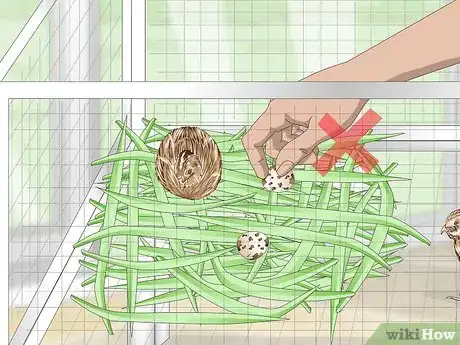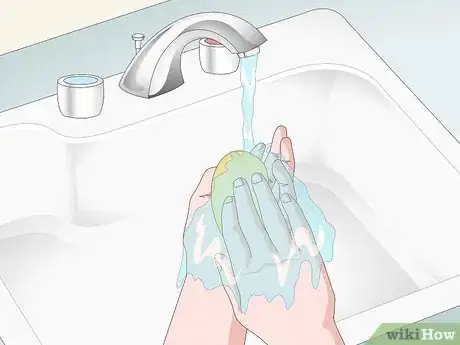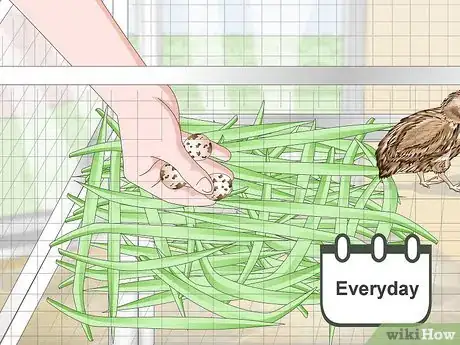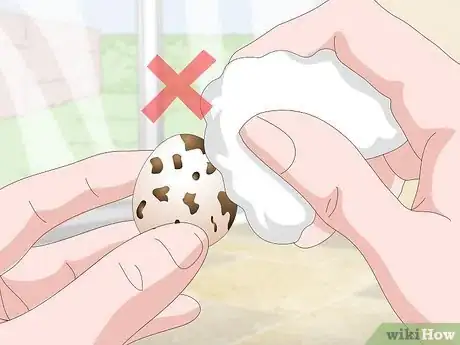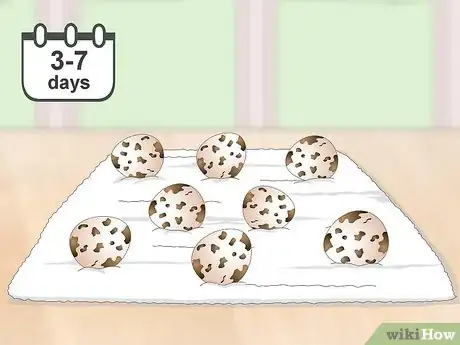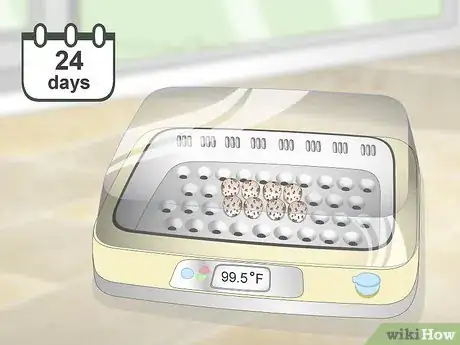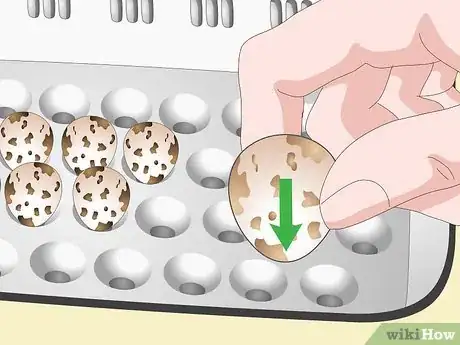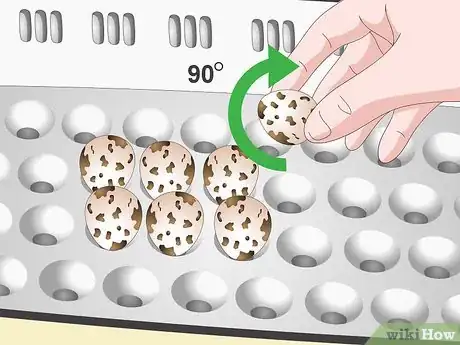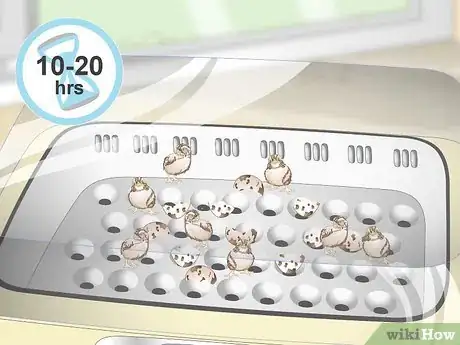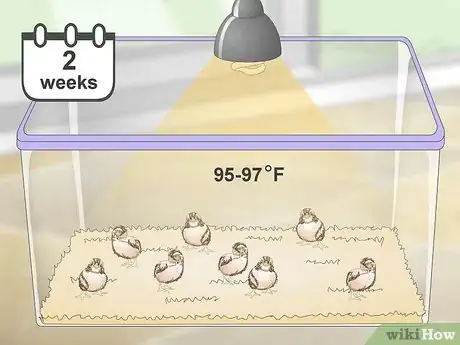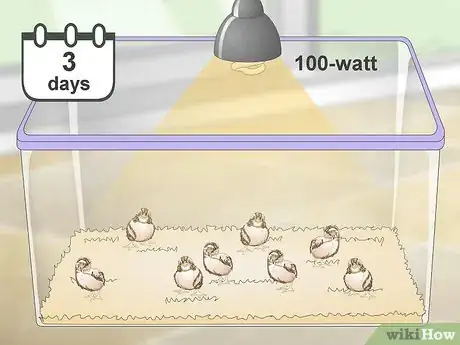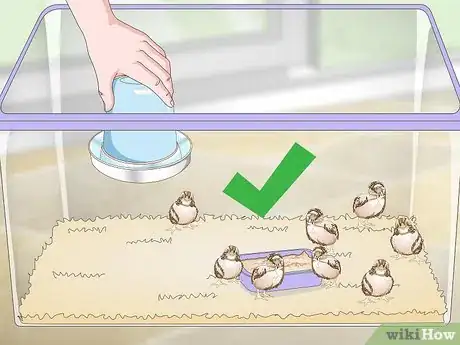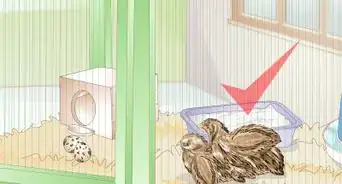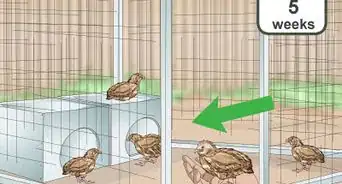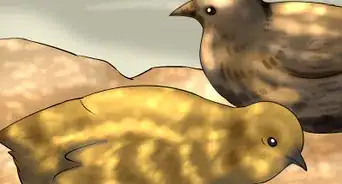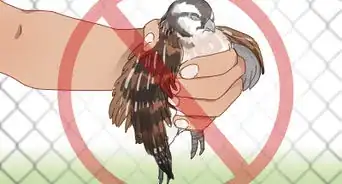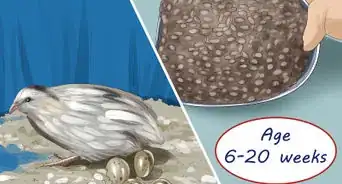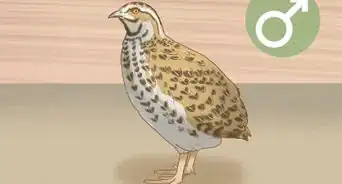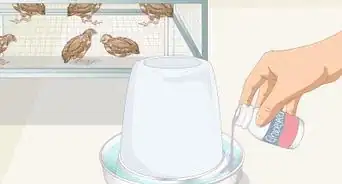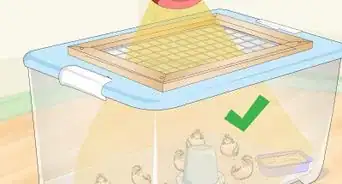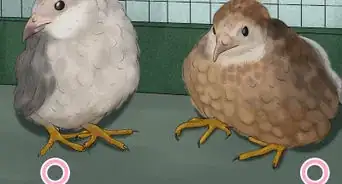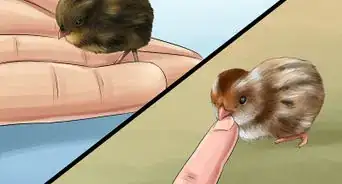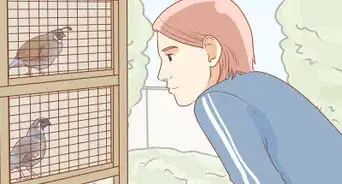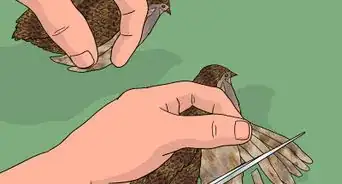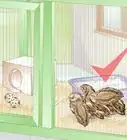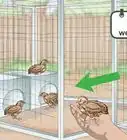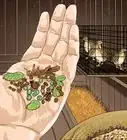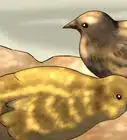This article was co-authored by wikiHow staff writer, Danielle Blinka, MA, MPA, and Amy Harrison, a trusted member of wikiHow's volunteer community. Amy Harrison has over five years of experience working directly with poultry. She has worked on a rural chicken farm built around marketing free-range eggs, where she managed the care for the poultry year-round. She has experience breeding chickens and quail, caring for newborn poultry, handling their health issues, and managing their dietary needs.
wikiHow marks an article as reader-approved once it receives enough positive feedback. In this case, 94% of readers who voted found the article helpful, earning it our reader-approved status.
This article has been viewed 163,690 times.
Learn more...
Quail are quickly becoming popular for hobby and backyard farms for their eggs and meat. In nature, quail begin breeding in the spring and continue through autumn, but you can extend their egg production with artificial lighting. If you want to breed your quail, place them in a safe nesting cage. Then, provide them with a healthy diet and create favorable breeding conditions. Once they lay eggs, you can allow the quail to incubate them or hatch them yourself.
Steps
Setting up a Habitat
-
1Set up the breeding cage at least 2-6 weeks before spring. Quail typically start breeding during the spring and continue to lay eggs through autumn. Since it will take the quail 2-6 weeks to get comfortable in their new environment, set up the habitat a few weeks before you plan to start breeding your birds.[1]
- For example, early February is a great time to set up your quail habitat and place the birds inside. By early spring, they should be comfortable in the cage.
-
2Put your cage in a peaceful location away from predators. Your quail won’t lay as many eggs if they feel stressed, so keep them somewhere they’ll be undisturbed. You might build them a coop or place them near a wall so they feel safe. Keep pets and other animals away from the cage.[2]
- If the quail are in your home, don’t place them near loud sounds, like the TV or a radio. Additionally, keep them out of high traffic areas.
Advertisement -
3Make sure each quail has at least 1 sq ft (0.093 sq m) of floor space per bird. Your quail should be able to move about the cage freely and comfortably. Since you may be hatching eggs, a bigger cage is optimal for breeding quail.[3]
- If you notice the birds seem cramped or fight a lot, move them to a bigger cage.
Feeding Your Breeders
-
1Provide a breeder feed mix daily. Always feed breeder quail with a mix formulated for breeders. This will provide them with the necessary nutrients for producing healthy eggs. If they aren’t properly nourished, the quail may not produce as many eggs.
- Make sure the food is kept off the ground. If you have your quail in a cage, hang the feeding trough at the birds’ back level. If the quail are on the ground, provide bedding beneath the trough so the quail can comfortably stand in front of the feeder.
-
2Add a calcium supplement if the quail aren’t producing eggs. Good calcium supplements for quail include crushed oyster shells, crushed limestone, and calcium premix.[4] Mix your chosen supplement into their feed to increase the amount of calcium in their diet. The extra calcium will encourage the quail to produce more eggs. Additionally, the eggs may be of better quality.[5]
- You can find a calcium supplement at a feed store or online.
- Calcium premix is the best option for increasing healthy egg production through supplementation.
-
3Give a constant supply of fresh, clean water. Dump out the water trough every day, then rinse it before you refill it with clean water. If you notice your quail are finishing their water early, provide a bigger water trough or an additional water source.
- The water dish can hang at the quail's back level or sit on the ground in front of some bedding.
- Disinfect the water trough at least once a week using a diluted bleach solution.
Encouraging Quail to Mate
-
1Place up to 3 females per male in the breeding pen. In the wild, quail are monogamous, so they pair off. When they’re kept on farms, male quail may breed with 3, 4, 5, or even 6 females! You can pair your breeding quail in 1:3, 1:4, or 1:5 male-to-female pairs.[6]
- Don’t place more than 1 male in a cage at a time. The males will fight to establish dominance and impress the females.
- Paired quails will usually produce more eggs and will pay more attention to their chicks. However, you will likely have more live chicks if you breed the male with 2 or 3 females.
- If you want to eat the eggs, don't put a male into the cage. Female quail will lay eggs whether or not the male is present. However, they must mate with a male to produce fertile eggs that will have chicks. You can keep as many as 5 females together at one time.[7]
-
2Provide your quail with 14 to 16 hours of light daily. Sunlight is best for your quail, but you can also use an artificial UV lamp. This encourages the quail to breed because they typically mate during spring and summer when the days are long.[8]
- Don’t give them more than 16 hours of light daily, as they need at least 8 hours to sleep at night.
-
3Keep your pen at around 70 °F (21 °C) to encourage breeding. Use a heater or fan to adjust the temperature of the breeding pen. Cool or very warm temperatures will discourage the quail from mating.[9]
- Place a thermometer in the pen so you can monitor the temperature and make adjustments when necessary.
-
4Provide your quail with straw and hay so they can nest. In nature, building a nest is part of the breeding process. Paired quail will build a nest together before they mate. Giving your quail plenty of fresh straw and hay will encourage them to build a nest and lay eggs. Also add a cardboard or wood piece so they can have a new environment. [10]
- Change out soiled straw and hay that isn’t used for nest building. Replace it with fresh straw and hay so the birds have a clean, comfortable environment.
Leaving Eggs in the Nest to Hatch
-
1Expect most of your eggs not to survive natural incubation. Quail eggs require a lot of attention if they're going to develop properly. The parents will need to keep the eggs very warm at all times. Unfortunately, it's common for quail to either not become broody or abandon their nest for periods of time, so their eggs don't thrive or sometimes don't even get incubated. [11]
- It's best to use an incubator to hatch your eggs, as you'll get more healthy chicks.
-
2Wear gloves to remove eggs that are visibly damaged. Eggs that are cracked and misshapen may spoil the entire lot of eggs. It's best to remove these eggs and throw them away. However, you don't want to disturb the eggs that you hope to hatch. Carefully pluck the damaged eggs from the nest or incubator.
- Only remove eggs that appear very damaged, which may spoil the healthy eggs. If you are trying to make the quail incubate them, you don't want to accidentally make the quail abandon their eggs.
-
3Avoid touching the eggs you want to keep, as the parents may reject them. Quail may abandon eggs if you handle them, which means the eggs will not incubate properly. Observe the eggs to monitor their progress, but don't pick them up, turn them, or move the quail off of them.
- An interruption in the incubation process may result in the eggs going bad and not hatching. If they do hatch, it's possible the chick may not thrive, as it won't develop properly.
-
4Make sure the parents sit on the eggs for 17-24 days. The mother hen and father must keep the eggs warm for the entire incubation period in order for the eggs to hatch properly. They will likely take turns sitting on the eggs and may sometimes sit on them together. As long as at least one parent is on the eggs, they should continue incubating.
- Paired couples are more likely to work together.
- Most breeds of quail hatch in 23-24 days, but Japanese quail usually hatch in 17-18 days.
Using an Incubator to Hatch the Eggs
-
1Wash your hands frequently to avoid contaminating your eggs. If you're going to collect and handle the eggs, you need to have clean hands. Scrub your hands with a mild soap under warm, running water for at least 20 seconds. Then, rinse your hands clean. Dry them with a clean towel.
-
2Collect the eggs every day, as the hen will lay about 1 egg a day. Each hen will lay 1 egg a day until she's finished laying all of the eggs in this clutch, which is one batch of eggs. You need to check the nest every day and remove the eggs so that they don't start incubating in the nest. If you're using an incubator, you want to incubate the eggs on your schedule.
- If the eggs start and stop incubating, the chick likely won't develop properly. If the egg hatches at all, the chick will likely be unhealthy.
-
3Throw out eggs that are cracked, misshapen or very large or small eggs. These eggs will not produce healthy chicks, if they hatch at all. Very large eggs often hatch unhealthy chicks, while small eggs typically produce tiny chicks that won’t thrive. It’s best to remove the eggs and throw them in your garbage.
- A single bad egg can contaminate your healthy eggs, so if you’re in doubt, throw out the egg. However, make sure you are 100% sure that that is a bad egg. You wouldn't want to throw away a good egg!
-
4Avoid wiping the outside of the eggs. The eggs will have a natural protective barrier on their shell, which you can’t see. The protective coating protects the quail chick from bacteria and germs. It’s best to avoid cleaning or handling the eggs before you hatch them.
-
5Let the eggs rest for 3-7 days after collecting them. For the first 3 to 7 days after you collect the eggs, let them rest in a location with a temperature of 55 to 65 °F (13 to 18 °C). Letting them rest for a few days will help prepare them for incubation.
- Don’t place fresh and stored eggs together.
- The longest you can safely leave the eggs to rest is 10 days, but it’s better to place them in the incubator before a week has past.
-
6Place the eggs in an incubator for up to 24 days. Set the incubator at a temperature between 99.5 to 102 °F (37.5 to 38.9 °C). Mist the eggs as needed to maintain a humidity level of about 58 percent. Leave the eggs in the incubator for 24 days or until they hatch.[12]
- Attach a hygrometer to the incubator, which measures the humidity.
- You can find incubators that spray the eggs for you, or you can maintain the humidity by keeping a dish of water in the incubator.
-
7Keep the small end of the egg below the large end. The air pocket will be on the large end of the egg. It’s important that the chick develop with its head toward the large end. If the large end is on the bottom, the chick may develop with its head on the wrong end, making it difficult for the chick to survive.
-
8Turn the eggs 90 degrees at 3-5 times a day while they’re incubating. Check on the eggs every 4 to 5 hours so you can turn them. Turn the egg often to ensure the chick develops properly.[13]
- You can purchase an egg turner to turn them for you, if you like. Some incubators include an egg turner that does this automatically.
Caring for the Chicks
-
1Expect the chicks to take 10 to 20 hours to fully hatch. After about 24 days of incubating, the chicks will start to hatch. Don’t help them, as chicks who cannot hatch by themselves are unlikely to thrive. The chicks will rest frequently as they hatch, so expect it to take about 10 to 20 hours for them to fully hatch.
- Give eggs that don’t hatch up to 1 day after their expected hatch day. At this point, you should throw out the eggs, as they’re unlikely to hatch. If they do hatch, the chicks likely won’t be healthy.
- Although most quail breeds take between 23-24 days to incubate, Japanese Quail usually take 17-18 days to hatch. If you're raising Japanese Quail, expect them to hatch sooner.
-
2Place hatched chicks in a small box, called a brooder. The brooder is where the chicks will spend their first few weeks safely. Fill the box with wood chips to keep them comfortable and safe.[14]
- If you allowed your adult quail to incubate their own eggs, you can leave the chicks with them. However, they may not survive as well as they would in a brooder because their environment is harder to control.
-
3Heat the brooder to between 95 to 97 °F (35 to 36 °C) in the first 2 weeks. The chicks need to be kept warm so they can continue developing. As they grow, you can lower the temperature. Starting at week 3, lower the temperature by 5 degrees F (3 degrees C) every week until you reach a temperature of 75 °F (24 °C). This will help the chicks grow healthily.[15]
- Use a heat lamp to warm the brooder.
-
4Keep a 100-watt light on in the brooder for the first 3 days. Don’t turn it off at all, even for nighttime. The chicks need the light to help them find feed and water, as their eyes aren’t well developed. It will also help keep them from pecking at each other.[16]
- After the first 3 days, you can switch to a dimmer light. However, keep the light on as much as possible to discourage the chicks from pecking at each other.
-
5Give the chicks starter feed and water. Provide a constant supply of starter feed and fresh water. The chicks will graze throughout the day. Check on the feed twice a day to remove soiled food and refill the feeder. Dump and replace the water twice a day, as well.[17]
- Choose a very shallow dish for water so that the chicks don’t drown.
Community Q&A
-
QuestionDirectly after my quail lays an egg, can I put it in the incubator to hatch?
 Community AnswerIt can be done but this isn't an effective method to hatch quail chicks. You'll need to first collect enough eggs over a period of time (a week or 7 days) and then put them in the incubator to hatch. If you put the eggs in the incubator at random times they will hatch at different rates which is why it's better to jot down when they were laid and what date they entered the incubator at.
Community AnswerIt can be done but this isn't an effective method to hatch quail chicks. You'll need to first collect enough eggs over a period of time (a week or 7 days) and then put them in the incubator to hatch. If you put the eggs in the incubator at random times they will hatch at different rates which is why it's better to jot down when they were laid and what date they entered the incubator at. -
QuestionCan I keep males together without females?
 Community AnswerNo, you cannot. They will fight unless there are many females with them, so do not put them together.
Community AnswerNo, you cannot. They will fight unless there are many females with them, so do not put them together. -
QuestionHow can I get my quail to become broody?
 Community AnswerYou cannot force a bird into broodiness but you can encourage it. Provide nesting materials, hiding spots, calcium, a roo, lightning and do not disturb him while he is trying to breed.
Community AnswerYou cannot force a bird into broodiness but you can encourage it. Provide nesting materials, hiding spots, calcium, a roo, lightning and do not disturb him while he is trying to breed.
Things You'll Need
- Quail
- Cage
- Straw
- UV lamp (optional)
- Breeding feed
- Water dish
- Incubator (optional)
- Brooder
- Starter feed
References
- ↑ https://poultrykeeper.com/general-quail/breeding-quail/
- ↑ https://www.roysfarm.com/how-to-get-quails-to-lay-eggs/
- ↑ https://www.hobbyfarms.com/quail-raising-tips/
- ↑ http://free-journal.umm.ac.id/files/file/Effect%20of%20Dietary%20Calcium%20Sources%20and%20Levels%20on%20Egg%20Production.pdf
- ↑ https://www.roysfarm.com/how-to-get-quails-to-lay-eggs/
- ↑ https://www.hobbyfarms.com/quail-raising-tips/
- ↑ https://poultrykeeper.com/keeping-quail/
- ↑ https://www.roysfarm.com/how-to-get-quails-to-lay-eggs/
- ↑ https://poultrykeeper.com/general-quail/breeding-quail/
- ↑ https://www.roysfarm.com/how-to-get-quails-to-lay-eggs/
- ↑ https://www.hobbyfarms.com/quail-raising-tips/
- ↑ https://www.hobbyfarms.com/quail-raising-tips/
- ↑ https://www.hobbyfarms.com/quail-raising-tips/
- ↑ https://www.hobbyfarms.com/quail-raising-tips/
- ↑ https://www.hobbyfarms.com/quail-raising-tips/
- ↑ https://www.hobbyfarms.com/quail-raising-tips/
- ↑ https://www.hobbyfarms.com/quail-raising-tips/
- ↑ https://www.hobbyfarms.com/quail-raising-tips/
- ↑ https://www.hobbyfarms.com/quail-raising-tips/
- ↑ https://wildlife.tamu.edu/quail/northern-bobwhites/
- ↑ https://poultrykeeper.com/keeping-quail/
- ↑ https://www.hobbyfarms.com/quail-raising-tips/
About This Article
To breed quail, start by setting up a breeding cage 2-6 weeks before spring so your quail have time to get comfortable in it before the spring breeding season. Then, introduce your breeder quail to the cage so you have 1 male and up to 3 females, and feed them a breeder feed mix every day so the females produce healthy eggs. You should also provide your quail with 14-16 hours of light every day to encourage breeding. To learn how to care for quail eggs, scroll down!
